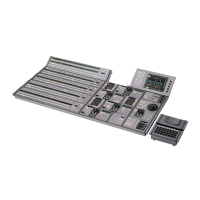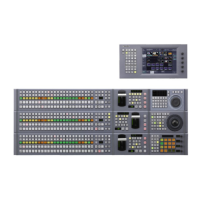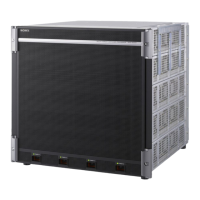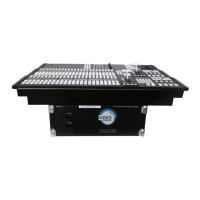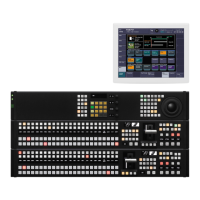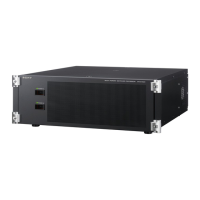Names and Functions of Parts of the Control Panel 39
• This shows the “transition rate” (the time
from the beginning of a transition to its
completion) set for an auto transition, in
frames.
• You can set the transition rate using the
numeric keypad control block, Flexi Pad
control block, or menu.
AUTO
TRANS
(transition)
button
• Pressing this button carries out an auto
transition of the set transition rate
(duration). The transition starts
immediately, and the button lights amber.
• When the transition completes, the button
goes off.
Pressing this button carries out the transition
as a cut (i.e. instantaneously).
Pressing this button, turning it on, enables the
pattern limit function.
• Use this button to set a pattern limit when
the [PTN LIMIT] button is off.
• Move the fader lever to the position of a
particular pattern size, and stop it there,
then press this button to set the pattern limit
range.
Chapter
2
Menus
and
Control
Panel
d
Wipe direction selection buttons
When a wipe or DME wipe is selected as the transition
type, you can press to light these buttons to select the wipe
direction.
The wipe proceeds in the direction from black
to white as shown on the pattern in the lists of
patterns see “Wipe Pattern List” (page 357)
and “DME Wipe Pattern List” (page 361), or in
the direction of the arrow.
The wipe proceeds in the opposite direction to
that when the [NORM] button is pressed.
NORM/REV
(normal/
reverse)
The wipe direction alternates between normal
and reverse every time a transition is
executed.
e
TRANS PVW (transition preview) button
When this button is lit, you can check in advance the video
changes during the transition, on the preview output from
the M/E or PGM/PST bank.
During the preview, you can use the fader lever, [AUTO
TRANS] button, and [CUT] button. One of the following
functions of this button can be selected in a Setup mode.
•
When the transition completes, the system returns to the
normal mode.
•
The transition preview mode is maintained while this
button is pressed.
•
Switching is made between the transition preview mode
and normal mode every time this button is pressed.
f
Pattern limit buttons
The following buttons are used to set a pattern limit.
g
KF (keyframe) button
Pressing this button to turn it on allows you to use the fader
lever as a keyframe fader.
h
Key status display
For each of the next transition selection buttons, [KEY1]
to [KEY4], the corresponding ON indicator lights when
the key is inserted. It also shows the priority (1 to 4) of
each key.
i
PRIOR (priority) SET button
While this button is held down, you can set the key
priority.
The setting mode when this button is pressed depends on
whether or not the [KEY PRIOR] button is lit, as follows.
•
When the [KEY PRIOR] button is off, the current key
priority is set.
•
When the [KEY PRIOR] button is lit, the key priority
after the next transition is set.
Press the [KEY PRIOR] button as required, to switch
between these two modes.
In either mode, hold down the [PRIOR SET] button, and
press the button ([KEY1] to [KEY8]) corresponding to the
key you want to bring to the front.
Notes
The key priority establishes a separate priority order within
each of the groups of keys 1 to 4 and keys 5 to 8. You can
make any setting within the groups of keys 1 to 4 or keys
5 to 8, but not for combinations of keys from different
groups. For example, it is not possible to set a priority
sequence of keys 1, 5, and 2.
For details, see “Setting the Key Priority in the Transition
Control Block” (page 98).
The following controls are used as the independent key
transition control block.
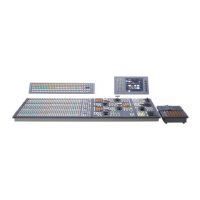
